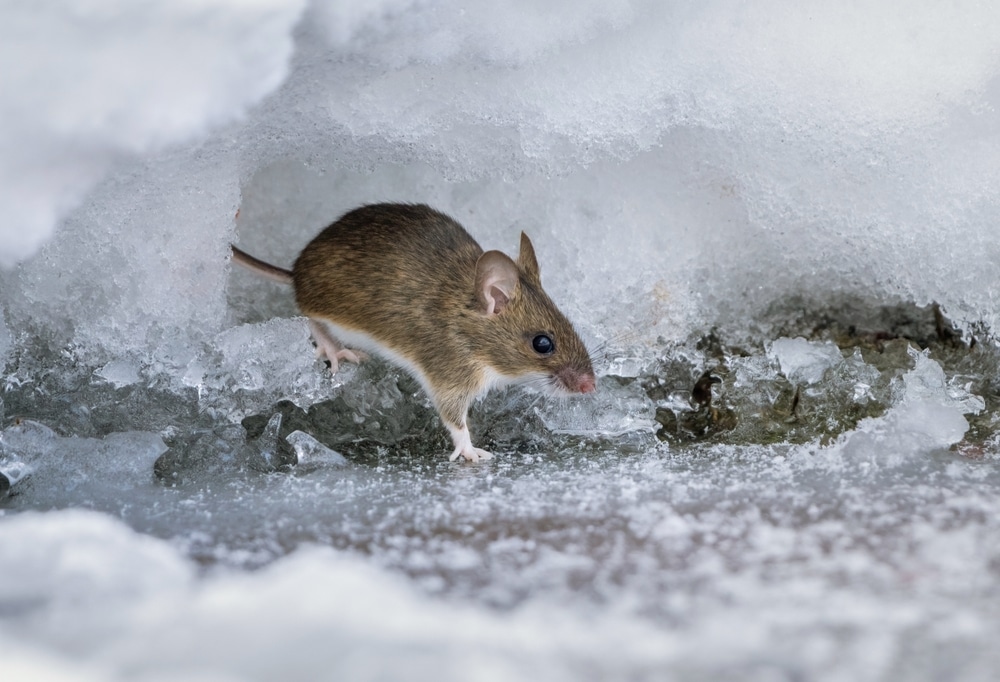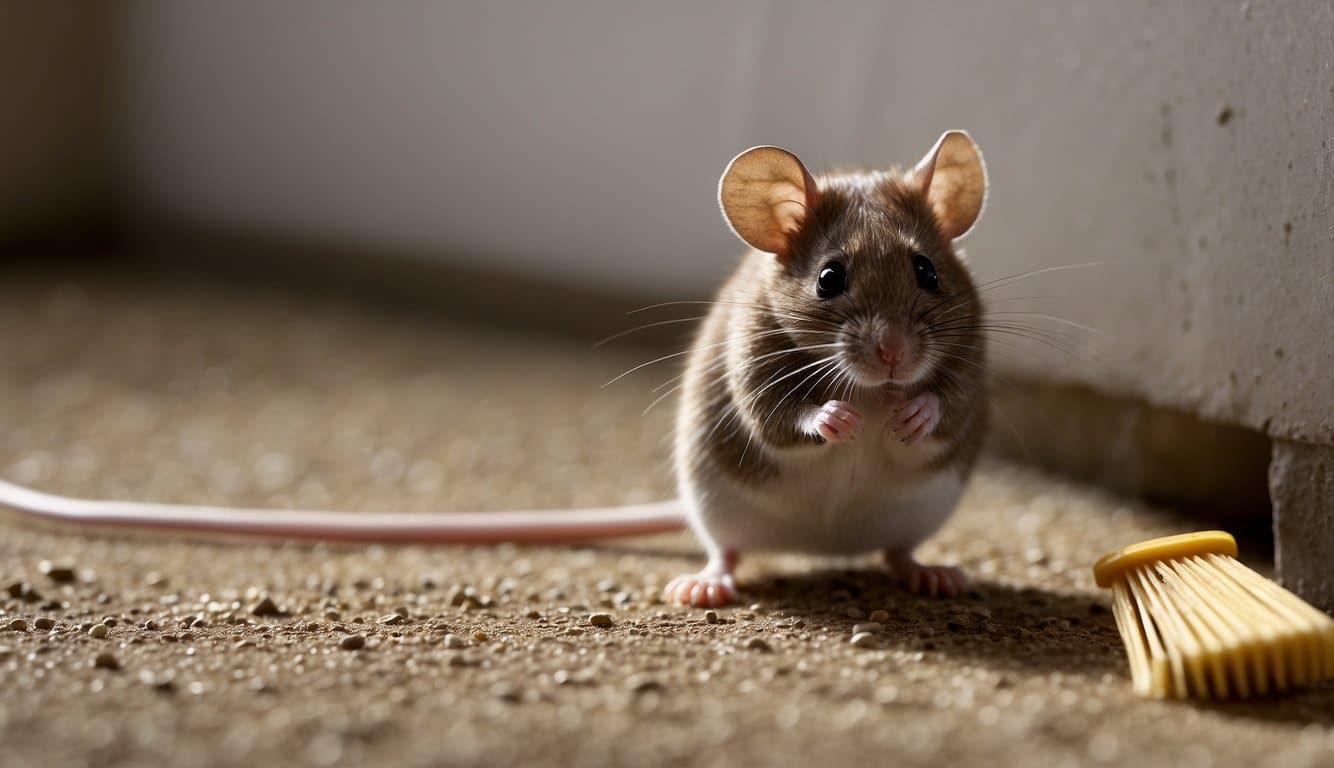Entry Points: Mice Highway
Before you set up your defenses against these furry invaders, know this: your home is crisscrossed with pathways that mice exploit with remarkable ease.
Common Entry Spots
- Cracks and Holes: Mice use the smallest openings to gain access to your home. It might surprise you, but they can squeeze through spaces as tiny as a dime!
- Windows and Doors: Ensure weather stripping is intact, as mice can slip through gaps you wouldn’t think twice about.
- Utility Lines: Any place cables, gas lines, or plumbing enter your home could be a ticket inside for mice. Try this guide for an in-depth look at how to mouse-proof these areas.
Structural Vulnerabilities
- Ventilation Points: Mice see vents as welcome signs, especially if they’re not covered with the right materials. Mesh screens can help block their entry.
- Garages: These often-overlooked spaces provide ample opportunities for mice to set up shop. Keep an eye out for gaps or openings mice might be exploiting as entry points. Check out these steps for finding where mice are entering your garage.
Rodent Behavior: Sneaky Critters
Mice are clever and adaptable creatures, finding crafty ways to enter your home, particularly as the seasons change and their needs shift.
Seasonal Patterns
- Spring: With the warmth encouraging activity, mice look for nesting sites, and your house is a prime real estate.
- Fall: Cooler temperatures drive them to seek warmth, often leading them to squeeze through the smallest of home openings.
Nocturnal Activities
- While you’re sleeping, mice are scurrying. Their peak hours of mayhem are during the night, which means they’re often undetected.
- They explore and memorize routes, ensuring that they can make a quick getaway if they sense danger.
Sealing the Deal: Fortify Your Home

Ready to become a home-fortifying hero? It’s time to roll up your sleeves and start sealing off the tiny invaders’ secret passages. You’re in for an adventure—so let’s get down to the nitty-gritty of mouse-proofing your fortress.
Materials to Use
First things first: assemble your anti-mouse arsenal.
- Steel Wool: Mice can’t chew through these tough fibers.
- Caulk: Ideal for sealing up those smaller cracks and crevices.
- Copper Mesh: Tightly packed, it’s a great filler that deters gnawing.
- Hardware Cloth: Perfect for covering larger gaps and vents.
- Door Sweeps: Seal the gap under doors to deny mice a welcome mat.
DIY Sealing Tips
Now for the fun part. It’s a strategic game of hide and seek—except you’re making sure the mice stay hidden… outside!
- Take a Closer Look: Mice can squeeze through openings as small as a dime. Inspect the perimeter of your home for any telltale gaps.
- Get To Filling: Use your selected materials to fill up holes. Remember, steel wool before caulk or spray foam creates a formidable barrier.
- Think like a Mouse: Check your roofline, vents, and where utilities enter your home—the common mouse highways.
Sanitation and Prevention: Cleanliness Is Key
Keeping your home free from mice isn’t just about setting up traps; it’s about making your home less enticing in the first place. Ensure your house doesn’t serve as a mice magnet by maintaining cleanliness and adhering to strict sanitation protocols.
Food Storage Protocols
- Seal your food: Store grains, pet food, and other dry goods in airtight containers. Mice have keen noses and can sniff out even the smallest crumbs from a distance.
- Fridge vigilance: Regularly check your fridge for forgotten leftovers and spillages. Even a tiny bit of juice or a crumb of cheese can be a feast for a mouse.
Regular Maintenance Checklist
- Declutter regularly: Less clutter means fewer hiding spots for mice. Keep storage areas tidy and inspect them often for signs of mouse activity.
- Inspect and clean:
- Weekly:
- Sweep and mop floors.
- Vacuum carpets and furniture prone to crumbs.
- Monthly:
- Check for and seal any gaps around pipes or electrical lines.
- Clear debris and trim plants away from the exterior of your home to reduce shelter for mice.
Detection and Early Intervention
If you’re hearing mysterious scurries or finding droppings in the corners, it’s high time to check for unwanted furry guests. Let’s zero in on the telltale signs and nifty tricks to stay ahead of these tiny intruders.
Signs of Infestation
- Droppings: These little dark pellets are a dead giveaway.
- Shape: Like grains of rice, but beware, they’re not for your next stir fry!
- Location: Check along walls, inside cupboards, or near food sources.
- Noises: Ever hear a party at night that wasn’t on your calendar?
- Scratching or scurrying sounds in walls or ceilings as they rave about.
- Gnaw Marks: They’ve got dental care plans!
- Woodwork, wires, or cardboard. If it looks like it’s been nibbled, it probably has.
- Grease Marks: These critters are oil collectors.
- Dark smudges along walls or baseboards, their version of leaving breadcrumbs.
Proactive Measures
- Seal the Deal:
- Close off entry points identified during inspection.
- Remember, mice are contortionists; any gap as wide as a pencil is a welcome sign.
- Clean Sweep:
- Keep your place squeaky clean—food crumbs and clutter are like a five-star mice resort.
- Store food in robust containers because a mouse’s nose knows no bounds.
- Landscape Grooming:
- Trim the outdoor runway—overgrown branches and shrubbery are like a bridge to Asgard for mice.
- Stack firewood away from your house unless you’re looking to provide a mouse Airbnb.
- Tech Tricks:
- Adopt a cat or a dog. They’re fur-tastic pest controllers!
- Electronic repellents can be a non-chaotic option for the tech-savvy homeowner.
Frequently Asked Questions
Tackling a mouse infestation starts with getting to the heart of how and why these crafty critters are sneaking into your home. Here’s the no-fluff, value-packed lowdown on the most pressing questions about mouse invasion.
What are the key entry points for mice sneaking into homes?
Mice make their way into your house through surprisingly small gaps and cracks. These include:
- Holes near foundations
- Gaps around window and door frames
- Openings around pipes and utility wires
- Vents and chimney openings
Can you detail the strategies for locating mouse entry points in a residence?
To pinpoint where mice are breaching your home:
- Inspect the exterior for cracks, holes, or gaps, especially where utilities enter your home.
- Follow the droppings, as these tiny telltales can lead you to their favorite paths and possible entry points.
In what season are rodent invasions most common in domestic spaces?
Rodent invasions peak during the fall and winter as mice search for warmth and shelter. Be extra vigilant during these times to prevent unwanted guests.
What are the natural methods to encourage mice to vacate a house?
Some natural deterrents to show mice the door include:
- Peppermint oil: Soak cotton balls and place them at suspected entry points.
- Cloves or clove oil: Mice dislike the scent which can act as a repellent.
- Steel wool: Stuff it into openings to discourage gnawing.
Despite a spotless home, what factors contribute to a mouse presence?
Even the cleanest homes can attract mice if there is:
- Pet food left out
- Fruit trees with fallen produce in your yard
- Bird feeders that spill seeds onto the ground
During the daytime, where do mice typically conceal themselves inside a house?
Mice are nocturnal and during the day, they typically hide out in:
- Secluded spots like cluttered attics or basements
- Behind appliances or within false ceilings
- Inside wall voids or furniture with crevices
